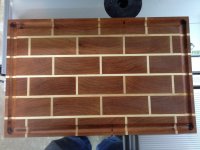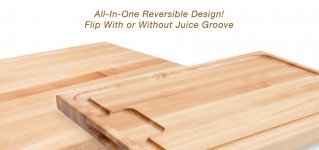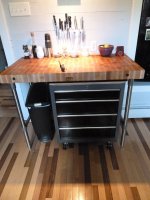rmwarren
Member
- Joined
- Jul 11, 2010
- Messages
- 3,063
So I do a lot of smoking and grilling, meat, pizza and some veggies. My smokers are outside (duh...) across the main deck, down 6 steps and across the lower deck. PITA to be hustling back and forth with trays for 40-50 paces transporting meat in and out.
In the meat department we don't have a good cutting board for carving the finished product, large enough for a brisket or a couple roasts or racks of ribs, with a blood groove, etc.
What I am envisioning is a combo cutting board/transport & dare I even hope for a serving tray?!?!? After the meat is done something that I can use to transport it back inside or the the main deck, or carve it on the spot, that will contain the juices. Go right to the table and serve?
I've never seen anything like this nor can I envision what it might look like, so hoping for some suggestions.
Thanks in advance,
RMW
In the meat department we don't have a good cutting board for carving the finished product, large enough for a brisket or a couple roasts or racks of ribs, with a blood groove, etc.
What I am envisioning is a combo cutting board/transport & dare I even hope for a serving tray?!?!? After the meat is done something that I can use to transport it back inside or the the main deck, or carve it on the spot, that will contain the juices. Go right to the table and serve?
I've never seen anything like this nor can I envision what it might look like, so hoping for some suggestions.
Thanks in advance,
RMW



![ScreenClip [2].png](/data/attachments/17/17879-d4b24b34a13592e05873f17aff003aa7.jpg?hash=1nJnu3uNrL)

